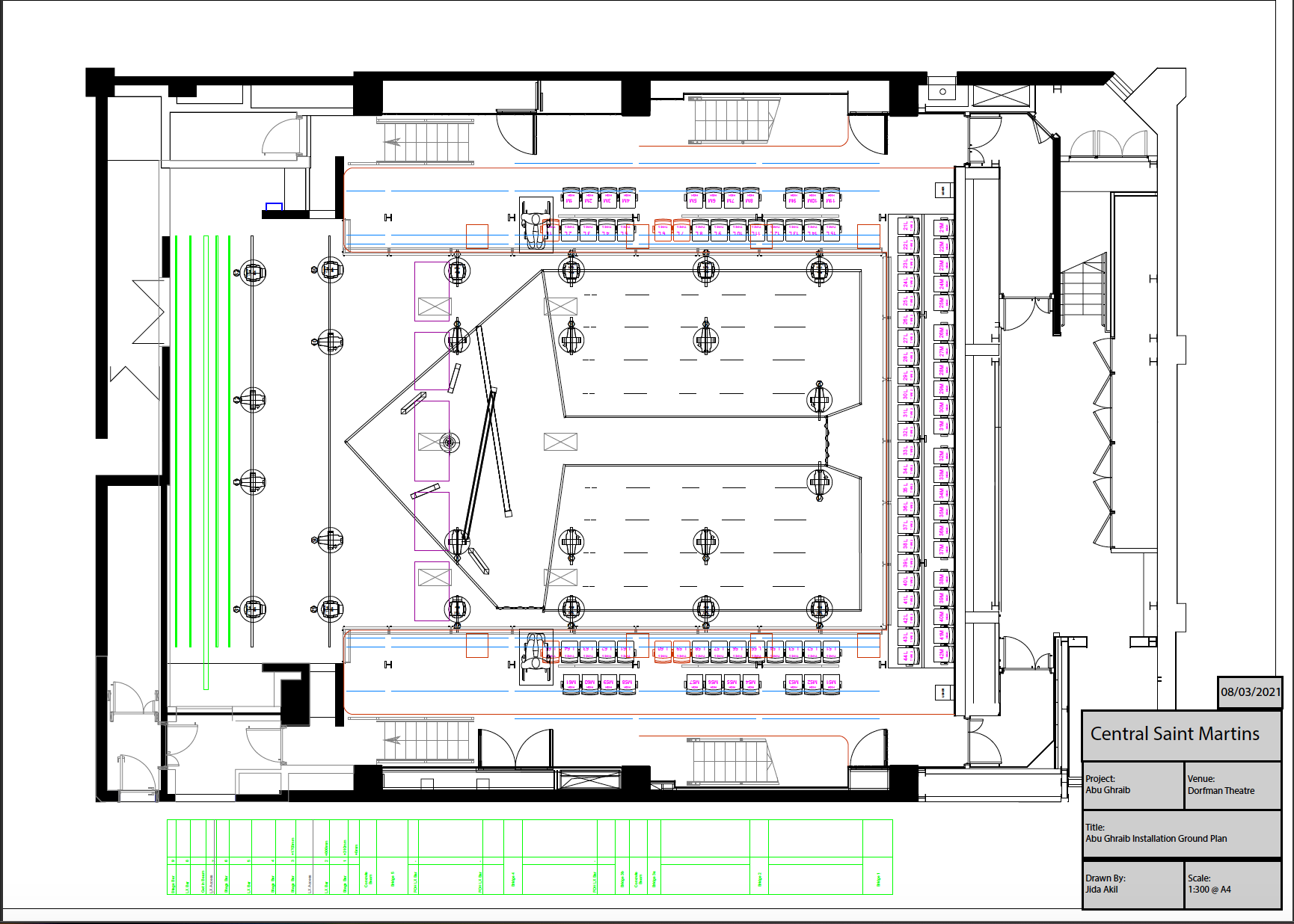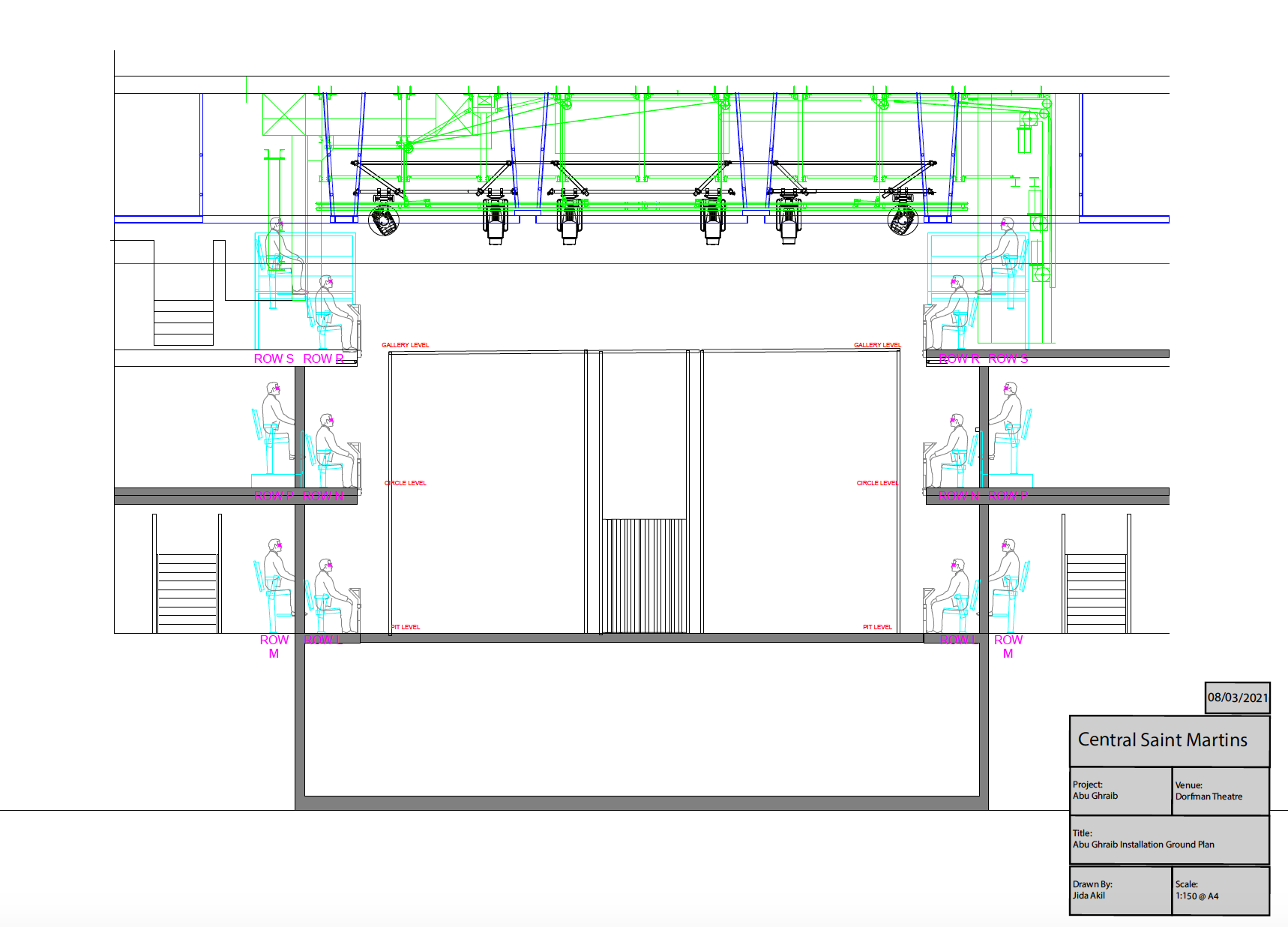PROCESS
I began by dissecting the compositions of the two “Hooded Man” photographs I was referencing. I was looking primarily at line & form of the body and the space that encapsulates it. I did this in order to understand all the different elements that created the composition, so that when I translate it into an installation design I can piece them together spatially. Some of these important elements included the conic shape of the hood, the draped scraps of the blanket, the corner of the room, and the metal railings.
![]()
![]()


Afterwards, I roughtly sketched my own composition that merged both photos using the form of the body from one image and the metal beams in the other.

The next step was to decide how the audience experiences this. My first idea was to create the bronze cast of the blanket & hood which a single audience member could stand within feeling the cold metal and hearing the buzzing wires from within the hood. However I abandoned this idea because I felt that it was not ethical towards Al-Qaisi’s experience. In tutorials with Laura, I voiced my concerns that I did not want his experience to be a spectacle. I also did not like this idea because in reality we as observers can never understand his experience, so I felt I was running the risk of belittling it.
So I re-assessed the direction I was going in and decided to play off my strengths with spatial design. Rather than turning the photograph of someone’s real story into a costume, I decided to attempt to create a performing space that embodies Al-Qaisi’s trauma through sensory experience.
So I re-assessed the direction I was going in and decided to play off my strengths with spatial design. Rather than turning the photograph of someone’s real story into a costume, I decided to attempt to create a performing space that embodies Al-Qaisi’s trauma through sensory experience.


My rough plan included a long corridor with silhouettes of clothing representing the detainment process of stripping and foregoing one’s humanity. The corridor leads into a room on the diagional. Metal railings & beams obscure & distance the audience from a suspended form modeled after The Hooded man. The distance is crucial as it aims to prompt the audience to reflect upon their role as a silent observer. The experience is enhanced with the sound design of buzzing electric wires and flashing lights to capture the moment of Al-Qaisi being photographed in that infamous pose.
3D MODELING & EXPERIMENTING WITH THE SPACE. Firstly, I had to decide what kind of space this would fit in. Laura advised me to go with a theatre space since I needed quite a bit of tech like lighting and sound.
I initially chose The Clare Studio at the Young Vic because I was familiar with it and it was a versatile studio space. I mocked up a set up using Rhino, but quickly realised that I would not be able to achieve the depth of space I designed. I tried to adapt the design to the space considering the brief was to create a performance that could tour/exist in multiple spaces.
The main adaption I had to do was for the corridor of clothes. I experimented with it looking like a cascade of suspended forms that you suddenly see through a black sharkstooth gauze in another room (top right of the mock up). I felt like it was straying away from the intention of capturing the detainment process.

A limitation of The Clare Studio was also the placement of the doors for the audience to enter & exit.
I made the decision that I would nead a rectangular space. Laura provided me with the plans for The Dorfman at the National Theatre. I designed the layout of the space in the below technical drawings.



The key features of the space include being able to remove some of the seating to increase the playing space of the installation. The depth allows me to elongate the corridor and also have space on either side to add multiple rows of the suspended clothing silhouettes. The exaggerated corridor also should help to heighten suspence as we approach the final room. I then created my 3D renders.
The first step was to create the corridor. I designed the the clothing silhouettes as wireframes on Blender because the jagged & sharp lines juxtapose the fragility of the blanket Al-Qaisi is draped in for the photographs. I felt there was a strong distinction between the strength and the weakness there. Additionally, Laura voiced concern that this corridor might look “too beautiful” so I wanted to avoid that as much as possible by making the forms less organic.
I also experimented with the idea of representing the amount of victims there were, even if we don’t know their names and stories. So I tried a infinity room effect by adding multiple rows each separated by a gauze so that they fade out. This was a fairly successful part of the process and didn’t require too much trial.
![]()
So then I tried backlighting it to get more of a blinding effect as you walk into the room but it felt very religious, like a deity/god descending, which was not the intention at all. I tried adding the metal railing designs to improve it, but it did not change much. I realised another issue was that the suspended figure was too high above eye level.
I had quite a few tutorials with Laura about this because I was struggling a lot with the lighting design. We both felt it looked too much like “science-fiction” and “darth vador” even.
In hindsight, I should have collaborated with a lighting designer or at least someone who understands it better than me. But I did learn a lot about creating atmospheric lighting. If I were to re-visit this process I would have planned my lighting far in advance to actually rendering the design, but it was still useful to play around with different options on the spot.
I ended up warming up the lighting and decreasing the contrast in order for the room to be more visible, and changing the wall finish to a lighter color like the photographs instead of black. I also changed the metal material to a blanket textile for that strong visual distinction between the fragility of the figure and the oppressiveness of the space.![]() The lighting experimentation was a time-consuming and challenging aspect of the process, but I learned a lot about how light, textures, and materials interact. It was really difficult to imagine how the lighting would behave when it was a digital render, so I do realise that if I was testing this out in a physical space I would have likely got a grip on it faster. It was a learning experience about capturing light in a digital model too.
The lighting experimentation was a time-consuming and challenging aspect of the process, but I learned a lot about how light, textures, and materials interact. It was really difficult to imagine how the lighting would behave when it was a digital render, so I do realise that if I was testing this out in a physical space I would have likely got a grip on it faster. It was a learning experience about capturing light in a digital model too.
I also experimented with the idea of representing the amount of victims there were, even if we don’t know their names and stories. So I tried a infinity room effect by adding multiple rows each separated by a gauze so that they fade out. This was a fairly successful part of the process and didn’t require too much trial.
So then I tried backlighting it to get more of a blinding effect as you walk into the room but it felt very religious, like a deity/god descending, which was not the intention at all. I tried adding the metal railing designs to improve it, but it did not change much. I realised another issue was that the suspended figure was too high above eye level.
I had quite a few tutorials with Laura about this because I was struggling a lot with the lighting design. We both felt it looked too much like “science-fiction” and “darth vador” even.
In hindsight, I should have collaborated with a lighting designer or at least someone who understands it better than me. But I did learn a lot about creating atmospheric lighting. If I were to re-visit this process I would have planned my lighting far in advance to actually rendering the design, but it was still useful to play around with different options on the spot.
I ended up warming up the lighting and decreasing the contrast in order for the room to be more visible, and changing the wall finish to a lighter color like the photographs instead of black. I also changed the metal material to a blanket textile for that strong visual distinction between the fragility of the figure and the oppressiveness of the space.
NEXT: OUTCOME︎︎︎
© Jida Akil 2025